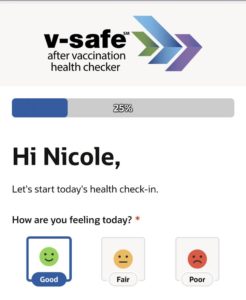
My brain is wired for panic
At one week out from my vaccine, I’ve had no new concerns. I have friends and family members reporting fever, fatigue, malaise, nausea, and vomiting – sometimes after the first dose – so I’m grateful to my immune system for all the favors it’s doing for me. Keep it up, immune system!
I’ve had a news article come up on several of my feeds lately, and so today’s diary is going to be about the Norway data and reading breaking medical news articles.
The article in question, depending on your news source of choice, begins with the headline “Norway Raises Concern Over Vaccine…” or “23 Die After Pfizer Vaccine…”; and that’s certainly a headline that will raise concern. I’m concerned! But we’ve been talking a lot about science lately, and the way that our brains tell us things that may or may not be strictly true, so I’m going to take you through a deep dive into the publicly available information and what it means from a scientific standpoint.
The article I’m using is from the British Medical Journal (a peer-reviewed publication with reasonable standing in the medical community, so a source I trust), but it reflects most of the same information you’ll find from any news source that is doing its research: Norwegian physicians had reported 23 deaths in patients who had recently received the Pfizer coronavirus vaccine. Those deaths were in care home patients (nursing home patients), many of whom were “very frail”. Some of those patients underwent autopsies and Norwegian health authorities felt that the side effects of the vaccine may have contributed to the deaths of the patients.
I’m going to walk you through the way I responded to this information, and let’s see where it takes us, shall we?
Brain (FULL PANIC MODE ON): That’s a lot of deaths! What’s going on?!! Why are all these people dying in Norway?! I need to call my nursing homes and make sure nobody is dead!! What if I have been telling people bad information?! What if I’m a bad scientist and a worse doctor?!
My brain is very excitable. It is also basically programmed for threat avoidance, because our brains are supposed to keep us alive, so it’s better in general if they’re a little paranoid (especially if you’re living in a world full of unpredictable things actively trying to kill you, as humans have done for much of our history). But that means that sometimes we have to take a moment, let the initial shock and awe wear off, and take another look at what we’re seeing.
So let’s take a look, now that my brain has stopped running in panicked circles and screaming, shall we?
Step 1: How reliable is the source of my information?
I had the same general headline from multiple news sources, which is usually (but not always) a positive sign of reliability, and so I walked it back to a medical journal that I trust for confirmation.
The data itself comes from Norway – which has a centralized government-funded health care system, in which enrollment is automatic. Citizens have the option to purchase private insurance, but only about 10% of the population has done so. The relationship between the Norwegian government and the citizens of Norway is generally good. This means that they have ready access to certain health data through national registries, and the information we are being given is likely to be reliable.
Step 2: What are the actual facts being reported?
BMJ reports upwards of 20,000 doses of Pfizer’s vaccine were administered in Norway in the last few weeks and 23 deaths were reported in frail elderly patients “shortly after” receiving the vaccine. 13 of those deaths have been investigated — and it was felt in those cases that vaccination responses may have contributed to the deaths. The article also notes that around 400 deaths a week occur in care homes in Norway on a normal basis.
We are not given a clear definition of “frail” or “elderly”, although both of those terms are kind of a “we know it when we see it” thing for doctors. We also are not given any information about whether the reported deaths are more than the usual number expected. Remember — Norway is monitoring its citizens’ health just as closely as the US is (maybe more closely) and so it’s expected that medical personnel should report EVERYTHING so that the data scientists can sort it out.
Step 3: What is the relationship between the facts?
There is a potential correlation between administration of the vaccine and death in frail elderly patients. That means that it’s possible that these two numbers are going to move together: if more frail elderly patients are vaccinated, then more of them will die shortly after the vaccination at a rate of about 10 deaths per 10,000 doses administered. It’s also possible that these two numbers have nothing in common, and as more frail elderly patients are vaccinated, more of them do very well.
There is also concern for causation: in the patients whose deaths have been investigated thus far, it’s possible that vaccine responses may have been a factor in their deaths. That’s certainly a point of concern, and one that I’m going to be following for more information on..
Step 4: What other information do I already have that is important to consider?
Pfizer did present data on safety in patients who were age 80 and up — but as widespread vaccination programs take place, we have rapidly exceeded the number of people enrolled in clinical trials. That means that instead of 73,000 data points (Pfizer enrolled 43,000 people and Moderna enrolled 30,000 people in Phase 3) we have over 12 million in the US alone.
The more data we have, the smaller our p value gets, and that means that we can be more confident when we say that a particular reaction is (or is not) likely to be related to vaccination.
I take care of frail elderly patients in care homes on a regular basis. I worry about things like fevers, not eating well, vomiting, and diarrhea in those patients. They don’t have a lot of extra reserve — so when they get dehydrated, low on electrolytes, or hypoglycemic (low on blood sugar), that can be a really serious event that they may not be able to recover from. So I can certainly understand from a medical standpoint where enthusiastic vaccine responses (the kind that sent my otherwise-healthy colleagues home from work for a day) might have a devastating effect on someone without that reserve.
Step 5: What am I going to do with all this information?
I’m not going to let my brain tell me to panic. Panicking does not help me be a better doctor, and it does not help me provide better information to my patients.
I AM going to flag this topic in my mind as something that I want to continue to learn more about — I expect more data to come out as scientists and doctors across the world continue to observe and report what they are seeing, and I want to know what the data says. Because this is important.
I AM going to use the information I have to inform my discussions with frail elderly patients and their families. It’s going to be important to talk about the possibility of an enthusiastic vaccine response and what that means, as well as to talk about what their risk of catching COVID-19 is and what that means. I can’t make a decision about vaccination for my patients and their families; my job is to be the best resource that I can be for them, and to help them make the best decision they can for themselves — and that decision may be different from one patient to another.
Step 6: Keep learning.
Never stop learning. Never stop asking questions.
And don’t be afraid to say “I don’t know, but I’ll find out.”
- References for today:
Covid-19: Norway investigates 23 deaths in frail elderly patients after vaccinationModerna Completes Enrollment of Phase 3 COVE Study of mRNA Vaccine Against COVID-19 (mRNA-1273)
Coronavirus (COVID-19) Vaccinations – Statistics and Research (THIS SITE IS A RABBIT HOLE OF DATA)
